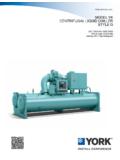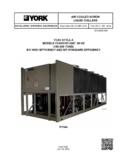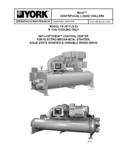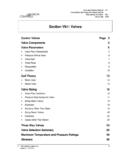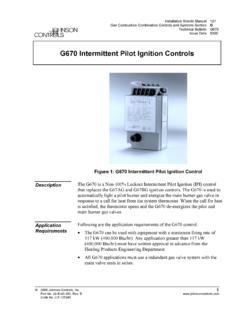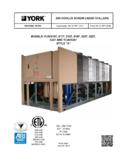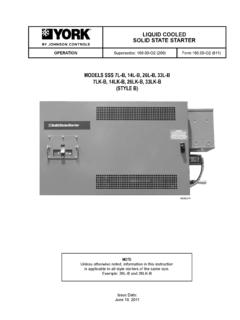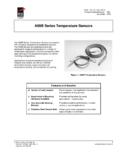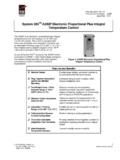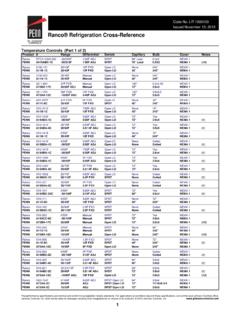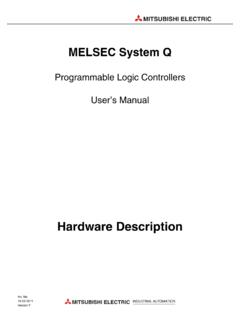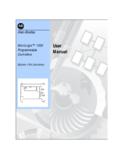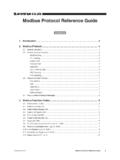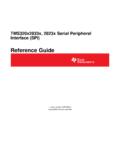Transcription of DX-9100 Configuration Guide - Johnson Controls | Product ...
1 FANs , Guides SectionConfiguration GuideIssue Date 0900 2000 Johnson Controls , No. Extended Digital Plant ControllerPage5 Introduction*5 Hardware Configuration10 Software Configuration11 DX-9100 Software Elements11 Configuration Tools11 Configuring the Controller14 DX-9100 Controller Selection15 DX-9100 Global Data15 Configuration Number (Version or Later)17 Password Feature (Versions , , , or Later)17 Analog Input Configuration18 Digital Input Configuration25 Analog Output Configuration26 Digital Output Configuration32 DO: Output Type34 Constants and Result Status40 Extension Module Configuration *42 Network Analog Input Configuration (Version 3 Only)*51 Network Digital Input Configuration (Version 3 Only)52 Network Analog Output Configuration (Version 3 Only)53 Network Digital Output Configuration (Version 3 Only)55 Programmable Function Module Configuration57 Control Algorithm Theory63DX-9100 Configuration Guide * Indicates those sections where changes have occurred since the last Configuration Guides DX-9100 Configuration Guide Algorithm 01 - PID Control ModulePage65 Algorithm 02 - On/Off Control Module 78 Algorithm 03 - Heating/Cooling PID Control Module (Dual PID)86 Algorithm 04 - Heating/Cooling On/Off Control Module (Dual On/Off)
2 98 Numerical Calculation and Other Function Module Configurations107 Algorithm 11 - Average107 Algorithm 12 - Minimum Select109 Algorithm 13 - Maximum Select111 Algorithm 14 - Psychrometric Calculation C113 Algorithm 15 - Psychrometric Calculation F116 Algorithm 16 - Line Segment119 Algorithm 17 - Input Selector121 Algorithm 18 - Calculator123 Algorithm 19 - Timer Functions125 Algorithm 20 - Totalization129 Algorithm 21 - Comparator133 Algorithm 22 - Sequencer136 Algorithm 23 - Four Channel Line Segment (Version or Later)152 Algorithm 24 - Eight Channel Calculator (Version or Later)154 Time Program Functions156 Time Schedule Configuration157 Optimal Start/Stop Configuration161 Programmable Logic Control Configuration174 Dial-up Feature with an NDM*188 Trend Log (Versions , , , or Later)192 Supervisory Mode Control Settings (General Module)*195 Controller Diagnostics204 Power Up Conditions204 Download/ Upload*206 Calibration Values209* Indicates those sections where changes have occurred since the last Guides DX-9100 Configuration Guide 3 Appendix A: SX Tool Item Description and TablesPage 211 Description of Items211 Item List213 Floating Point Numbers215 EEPROM Items215 Appendix B.
3 Item Structure217 General Module Items Structure*217 Programmable Function Module Items Structure223 Analog Input Module Items Structure226 Analog Output Module Items Structure228 Digital Output Module Items Structure229 Extension Module Items Structure230 Time Scheduling Items Structure*236 Optimal Start/Stop Items Structure237 Network Information Module Items Structure238 Network Digital Output Module Items Structure239 Network Analog Output Module Items Structure241 Network Digital Input Module Items Structure243 Network Analog Input Module Items Structure244 Appendix C: Programmable Function Module Items247 Algorithm 1 - PID Controller247 Algorithm 2 - On/Off Controller249 Algorithm 3 - Heating/Cooling PID Controller251 Algorithm 4 - Heating/Cooling On/Off Controller253 Algorithm 11 - Average Calculation256 Algorithm 12 - Minimum Selection257 Algorithm 13 - Maximum Selection258 Algorithm 14 - Psychrometric Calculation C259* Indicates those sections where changes have occurred since the last Configuration Guides DX-9100 Configuration Guide Algorithm 15 - Psychrometric Calculation FPage260 Algorithm 16 - Line Segment Function261 Algorithm 17 - Input Selector262 Algorithm 18 - Calculator263 Algorithm 19 - Timer Function264 Algorithm 20 - Totalization266 Algorithm 21 - Eight Channel
4 Comparator269 Algorithm 22 - Sequencer271 Algorithm 23 - Four Channel Line Segment Function274 Algorithm 24 - Eight Channel Calculator276 Appendix D: Logic Variables279 Description of Logic Variables279 Logic Variable Tables280 Appendix E: Analog Items and Logic Variables for theTrend Log Module*287* Indicates those sections where changes have occurred since the last Guides DX-9100 Configuration Guide 5DX-9100 Extended Digital PlantControllerThis document covers all three versions of the DX-9100 Extended DigitalController, including the DX-912x LONWORKS version. They include:Version 1 provides up to eight output modules, which are configured togive two analog outputs and six digital outputs (triacs).Version 2 provides six additional analog output modules, giving a totalof eight analog 3 the DX-912x LONWORKS version brings peer-to-peercommunication to the feature set of the Version 2 controller,and enhanced alarm reporting capability when used as anintegral part of an Building Automation System (BAS).
5 In this document, BAS is a generic term, which refers to theMetasys Network, Companion , and Facilitator supervisory specific system names are used when referring to DX-9100 is the ideal digital control solution for multiple chiller orboiler plant control applications, for the Heating, Ventilating, and AirConditioning (HVAC) process of air handling units or for distributedlighting and related electrical equipment control applications. It providesprecise Direct Digital Control (DDC) as well as programmed logic a standalone Configuration , the DX-9100 Controller has both thehardware and software flexibility to adapt to the variety of controlprocesses found in its targeted applications. Along with its outstandingcontrol flexibility, the controller can expand its input and output pointcapability by communicating with I/O Extension Modules on an expansionbus, and provides monitoring and control for all connected points via itsbuilt-in Light-Emitting Display (LED).
6 Versions 1 and 2 can communicateon the N2 Bus as well as on the System 91 Bus*, providing point controlto the full BAS Network or to the N30 system or Companion/FacilitatorSystem. The Version 3 controller uses the LONWORKS (Echelon ) N2 Busof the Metasys Control Module (NCM311 or NCM361 in Europe,NCM300 or NCM350 elsewhere) in place of the N2 Bus. *The terms System 91 Bus and Metasys Control Station are not used in North Configuration Guides DX-9100 Configuration GuideThe DX-9100 has two packaging styles. In Version 1, all terminals forfield wiring are located within the controller enclosure. Versions 2 and 3require a separate field wiring mounting base or cabinet door mountingframe, which enables all field wiring to be completed before the controlleris 1: Version 1 ( DX-9100 -8154)Figure 2: DX-9100 -8454 (Version 2)/DX-912x-8454 (Version 3)with Mounting BaseNote: The mounting base differs for DX-9120 and Guides DX-9100 Configuration Guide 7 The DX-9100 processes the analog and digital input signals it receives,using twelve multi-purpose programmable function modules, a softwareimplemented Programmable Logic Controller (PLC), time schedulemodules, and optimal start/stop modules.
7 Producing the required outputs(depending on the module Configuration ), operating parameters, andprogrammed of all versions of the DX-9100 Controller are achieved byusing a Personal Computer (PC) with GX-9100 Graphic ConfigurationSoftware (Version 5 or later) supplied by Johnson Controls . Changes tothe Configuration can be made by using an SX-9120 Service Module(Version or later).The DX-9100 unit (Versions 1 and 2) has two communication is called the N2 Bus or Bus 91 (the term Bus 91 is not used inNorth America) and is used to interface to a supervisory unit. The otherlink is called the XT Bus and is used to expand the DX-9100 input/outputcapability by interfacing up to eight XT-9100 or XTM-905 extensionmodules. The DX-9100 input/output can be extended by up to 64 remoteinput/outputs, analog or digital, depending on the type of the connectedextension modules and XP expansion connections are made on XP modules, which are monitored andcontrolled by the XT-9100 or XTM-905 modules.
8 For more details, referto the XT-9100 Technical Bulletin in the System 9100 Manual (FAN ). One XP module can provide either eight analog points oreight digital points. Two XP modules connected to one extension moduleprovides eight analog and eight digital points, or sixteen digital 1 or 2 of the DX-9100 can be used as a standalone controller or itcan be connected to a BAS through the RS-485 serial communications bus(N2 Bus or Bus 91).Version 3 of the controller (DX-912x-8454) brings peer-to-peercommunication to the feature set of the Version 2 controller, and enhancedalarm reporting capability when used as an integral part of a Metasys new communications features are provided by the LONWORKSN etwork, which enables Version 3 controllers to pass data from one toanother and to send event-initiated data to the NCM350 (NCM361 inEurope) Network Control Module, in the BAS.
9 The LONWORKS (Echelon)N2 Bus is used in place of the N2 Bus, and the NCM300 or NCM350(NCM311 or NCM361 in Europe) must be fitted with a LONWORKS(Echelon) driver Version 3 controller retains all the input/output point and controlcapabilities of the Version 2 controller, including the point expansionfeature using extension modules and expansion 1 and 2(N2 Bus)Version 3(LONWORKSN2 Bus)8 Configuration Guides DX-9100 Configuration GuideIn addition to the Version 2 features, the Version 3 controller has networkinput and output points, which can be configured to transmit and receivedata over the LONWORKS Bus. Each controller may have up to 16 networkanalog input modules, 16 network analog output modules, 8 networkdigital input modules, and 8 network digital output modules.
10 Whilenetwork analog input and output modules each contain a single analogvalue, the network digital input and output modules each contain 16 digitalstates, which are transmitted as a block between controllers. Thetransmission of point data is managed by the LONWORKS Network and isindependent of the supervisory functions of the BAS Network ControlModule (NCM). A network of Version 3 controllers can be installed toshare analog and digital data between controllers on a peer-to-peer basis; aNetwork Control Module is not required unless the network is to besupervised by a control strategies may now be performed in multiple DX-912xcontrollers without the need for network data exchange routines in asupervisory controller. Applications include the control of multiple,interdependent air handling units, and large hot water or chilled watergenerating plants with components distributed in various locations withinthe Version 3 controller has been approved as a LONMARK device andconforms to the LONMARK specification for network data 3: LONMARK TrademarkFurther information about compatibility and interoperability with otherLONMARK devices may be requested from your local Johnson CompatibilityConfiguration Guides DX-9100 Configuration Guide 9 Refer to Table 1 for additional information on System 9100 controllers:Table 1: Related InformationDoc
